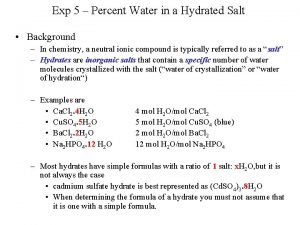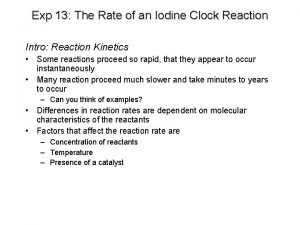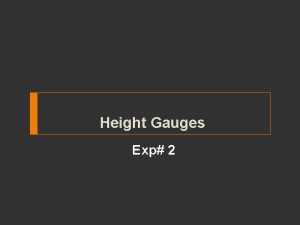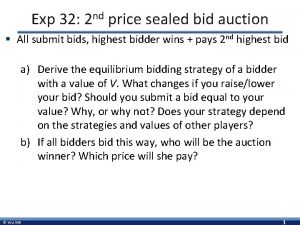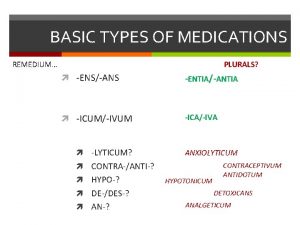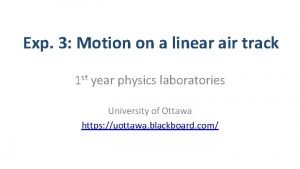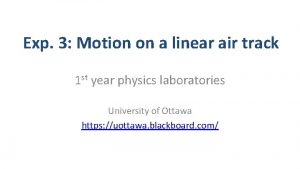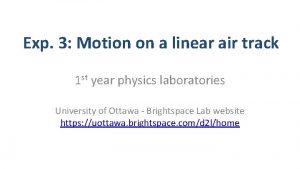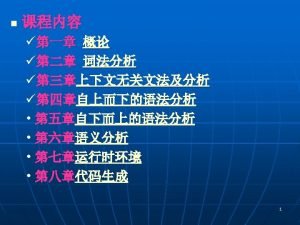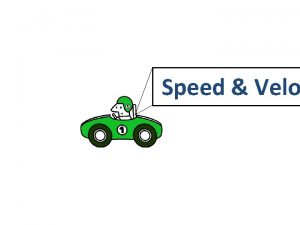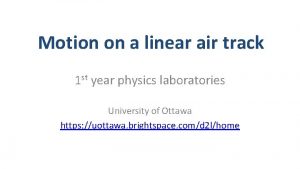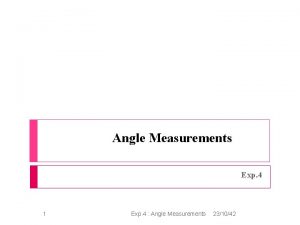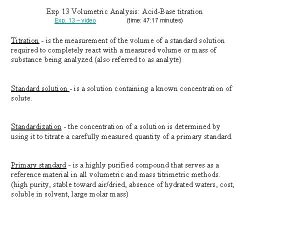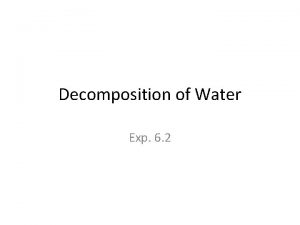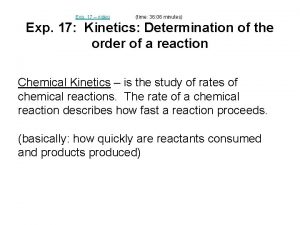Exp 3 Motion on a linear air track



















- Slides: 19

Exp. 3: Motion on a linear air track 1 st year physics laboratories University of Ottawa - Brightspace Lab website https: //uottawa. brightspace. com/d 2 l/home

INTRODUCTION • You will examine how the acceleration of a glider on an inclined air track is dependent on the angle of incline. – You will use a motion detector to determine the acceleration of a glider for different incline angles. – You will decide whether you can extrapolate your data for small angles to experimentally determine the acceleration for a vertical angle (free fall). • You will study the motion of a glider under a constant force to investigate Newton’s second law of motion. – You will accelerate your glider using a range of falling masses and experimentally determine the relationships between force, mass, and acceleration in a closed system.

PART 1 – Determining g on an incline summary • Measure speed and acceleration of a glider down an incline of varying angle and record your results in a table. • Using simply geometry, determine the relationship between the angle of incline and acceleration. • Extrapolate your data to experimentally determine the value of free fall acceleration, g.

PART 2 – Investigating Newton’s second law summary • Measure speed and acceleration of a glider as it is accelerated down a track by a hanging mass • Identify the relationship between the glider’s acceleration and the net force applied to it. You will extrapolate your data to determine a second value for free fall acceleration, g. • Determine the effect of the mass on the relationship between acceleration and force in your system.

The setup Air supply Air track

The setup Motion detector Glider

PRELIMINARY TASKS • Launch Logger Pro, turn on air supply (note, you are sharing the supply!), adjust the air flow. • Level your track using the adjustable legs. • Insert a 1 cm disc under the front leg of the track. • Collect position and velocity data as you launch the glider from the bottom of the track so that it slows to a stop about 1 m from its initial position before it returns. • Analyze the graphs of position and velocity vs. time and answer the questions in your laboratory report.

Simple motion on an incline Launching the glider:

PART 1 • Vertical force is F = Mg, where M is mass of glider and g is the gravitational acceleration. • The acceleration force along the incline is given by Ma = Mg·sinθ (1), • From the inclined track we see that sinθ = h/d (2). • Using (1) and (2) we have the relation a = g·h/d.

PART 1 (cont. ) • Measure thicknesses of the 1 cm and 2 cm aluminum discs using the vernier caliper. The thicknesses of these discs are used to calculate h. • With the 1 cm disc still under the leg of the track, record the position and velocity data of the glider as it slides down the incline. You should have a constant slope in the v vs. t graph. • Use a linear regression to determine the slope, along with its uncertainty, of the v vs. t graph using only the portion of the data for times when the glider was freely moving. • Repeat the trial twice using the 1 cm disc then increase the height by 1 cm and find the acceleration for various incline angles.

Part 1 – Determining g on an incline The aluminum dics:

Part 1 – Determining g on an incline Glider going down on the air track:

PART 1 (cont. ) • Prepare a graph of acceleration of the glider as a function of h/d. • Note that d = 1 m for this air track (the distance between the track’s legs). • Perform a linear regression showing the slope of the graph along with its uncertainty. • The slope of your graph will be your experimental value for the acceleration due to gravity. a = g · h/d Y axis slope X axis

PART 2 • The force on the glider is F = mg = (M + m)a where M is the mass of the glider and m is the falling mass (plus the hook!). • We can determine the acceleration due to gravity by finding the slope of a graph of a vs. m / (M + m).

PART 2 (cont. ) • We are working with a level track for this part (no spacer) under the leg. • Measure the masses of the glider as well as the hook and falling masses. • Connect the string to the glider and loop it through the two pulleys then connect the hook to the string. The hook should hang about 2 cm from the ground when the glider is at the pulley end of the track. • Collect data as the glider accelerates from one end of the track to the other by the falling masses. • Repeat each trial twice before increasing the falling mass by 5 g. You should not put more than 25 g on the hook.

Part 2 – Investigating Newton’s second law The pulleys and the hook for masses: The glider with attachment:

Part 2 – Investigating Newton’s second law Glider pulled by free falling masses:

PART 2 (cont. ) • Prepare a graph of acceleration of the glider as a function of m / (M + m). • You will need to calculate m / (M + m) for each mass that was used. • Perform a linear regression showing the slope of the graph along with its uncertainty. • The slope of your graph will be your second experimental value for the acceleration due to gravity. a = g · m / (M + m) X axis Y axis slope

DUE DATE CLEAN UP • Turn off the air supply, computer, and don’t forget to take your USB key. • Put the spacers and the masses back in the tupperware container. You may leave the mass hanger attached to the string for students in the next session. • Please recycle scrap paper and throw away any garbage. Please leave your station as clean as you can. • Push back the monitor, keyboard, and mouse. Please push your chair back under the table. • Thank you! • • • The report is due in 1 week before 4 pm in the lab drop box. If your report is late you will receive the following penalties: After 4 pm on the due date – 10 % After 4 pm the day after – 20% After 4 pm two days after – mark of 0 PRE-LAB • Don’t forget to do your pre-lab for the next experiment!
 Hubungan air dengan tanah
Hubungan air dengan tanah Scat orig no unam
Scat orig no unam Haskell exp
Haskell exp Mpls exp bits
Mpls exp bits Drift current and diffusion current in semiconductor
Drift current and diffusion current in semiconductor 2 exp 16
2 exp 16 Elematika za učenike
Elematika za učenike Natural logarithm in matlab
Natural logarithm in matlab Ln
Ln Isr-ccp-exp
Isr-ccp-exp Percent by mass of volatile water in hydrated salt
Percent by mass of volatile water in hydrated salt Aminophyllini
Aminophyllini 2 exp 8
2 exp 8 Exp 13
Exp 13 Beverage plants and machineries
Beverage plants and machineries Exp command
Exp command Exp height
Exp height 2 exp 32
2 exp 32 Rapid exp
Rapid exp Remedium cardinale
Remedium cardinale










